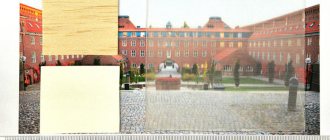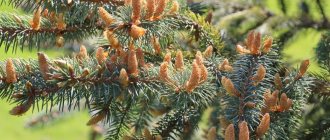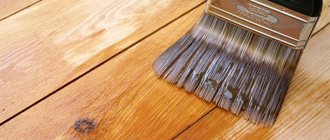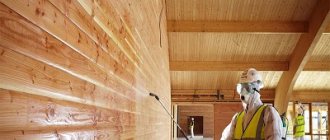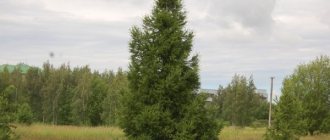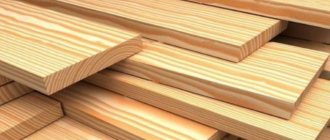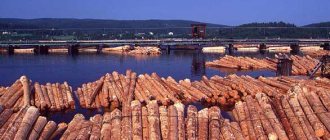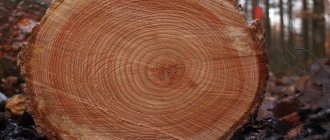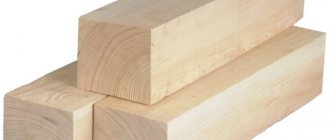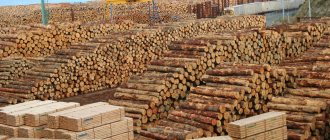Wood Expertise Center
Currently in Russia the housing issue is very acute. The need for comfortable and environmentally friendly homes is growing. This need can be satisfied by low-rise wooden housing construction.
The durability of a wooden house depends on the quality of the wood and construction technologies - built from high-quality raw materials, in compliance with all technologies, with proper operation, a house can last more than 100 years. The situation in the low-rise housing construction market requires the release of a legal and high-quality product (house kits). Certification can certify its quality.
Modern scientific advances make it possible not only to identify flaws in wood, but also to establish the time and place of cutting the tree, which is very important for determining the legality of the material. For many questions that concern both manufacturers and consumers of construction wood, you can contact specialized research centers equipped with the latest technology, capable of conducting examinations of the quality and origin of wood.
When certifying wooden log houses or house kits, specialists armed with knowledge in the field of wood science, dendrochronology and plant anatomy can solve a number of problems:
- establishing the legality of the origin of wood used to make lumber;
- determination of the species composition of wood and the timing of its harvesting;
- establishing the quality and grade of round timber and lumber in accordance with GOST and TU, as well as a number of other specific issues related to the research of various wooden materials (chopped logs, timber, rounded logs).
Humidity
When choosing lumber, an important criterion is its moisture content. Depending on the production technology, it is customary to distinguish two types of lumber:
- made from wood with natural moisture;
- made from dried wood artificially or naturally.
The former have a lighter shade and are heavier in weight of dry wood. Naturally, lumber of the second type is considered to be of higher quality. However, their production naturally will take a lot of time (2-3 years) and, accordingly, the cost of such products is much higher.
Dendrochronological method
A great contribution to the assessment of wood was made by the development of the science of dendrochronology, based on the study of tree rings. Tree rings are a chronicle that can tell about the most important events in the life of a tree, be it drought, harsh winter, pest attack, fire, changes in the hydrological regime of the soil, felling, improper care, mechanical damage to the trunk. And the time of each incident will be indicated by the rings with an accuracy of one year. With the help of dendrochronological examination, it is possible to establish the cause of death of a tree, the place and time of its felling, and the year of construction of any wooden structure.
This technique was first used at the beginning of the 20th century by the founder of dendrochronology, American astronomer Andrew Douglas, when establishing the age of fossil wood from the buildings of the Pueblo Indians. Later it became widespread in archeology, and has now found application in forestry, the woodworking industry and even art history.
Dendrochronological examination has become an important component in the system of measures to combat illegal timber trafficking. It provides an evidence base when investigating cases of illegal logging. Using this method, you can determine the place of origin of the wood and the time of felling. The examination is able to determine whether the stump remaining at the felling site and the trunk of the cut tree (lumber) were previously a single whole.
Lintab
Dendrological examinations are carried out using electronic equipment. One of the complexes that works with dendrochronological information is the Lintab device (equipped with the TSAP-Win analytical software package). It was developed by German physicist Frank Rinn.
However, this attitude in itself does not ensure success in research. Therefore, a person trying to work with lintab should have an idea of the factors of tree-ring variability.
Nowadays, an expert with modern knowledge and the latest scientific equipment can obtain a volume of information about wood that specialists would never have dreamed of several years ago.
Defect detection
Specialists of the Wood Expertise Center are able to diagnose all major wood defects in accordance with GOST 2140-81:
- presence of knots, cracks;
- defects in the shape of the trunk (tapered, rooted, ovality, growths, curvature);
- structural defects of wood (fiber inclination, curl, curl, root, false heartwood, internal sapwood, core, sprout, tar, pocket);
- fungal infections;
- biological damage and warping.
Identification of a number of defects (knots, cracks, defects in the shape of the trunk, chipping) is carried out visually and instrumentally when a specialist visits the location of the wood shipment. For this purpose, a sampling method is used, when a certain part of the samples is selected from a batch and, based on the frequency of occurrence of certain defects in this sample, a conclusion is drawn about the percentage of defects in general and about the grade of wood, compliance with the technical conditions of production and the terms of the supply contract.
Statistical processing of data on tree-ring variability
When it comes to luxury housing construction, special attention must be paid to the last point. Often, the quality of wood acceptable from the point of view of GOST and production specifications may not satisfy the high requirements of the customer. A striking example is the so-called sapwood coloration of wood caused by fungi (for example, blue), which does not reduce the hardness of the wood, but significantly worsens its aesthetic properties and affects water absorption.
For such groups of defects as structural defects of wood, fungal damage and biological damage, laboratory studies involving the use of microscopic equipment and the production of microscopic preparations for working in reflected and transmitted light are often necessary.
Requirements for lumber
Coniferous lumber constitutes the most common and accessible group. The sought-after pine and spruce are almost identical in technical characteristics, and their strength is identical. Therefore, they are ideal for solving numerous construction tasks.
The type of wood is influenced by the quality of the structure and processing. There are 5 types of raw materials.
Selected wood and grades 1-3 must have a moisture content of no more than 22%, and a surface roughness of no more than 1250 microns.
Grade 4 has no restrictions on moisture and roughness. These indicators are important. After all, sometimes a cheap product is sold under the guise of an expensive one.
The presence of blemishes and defects is the criterion by which the grade and quality of edged boards and timber are judged.
To indicate the type of wood, numbers, letters, dots, and stripes are used. Pine lumber up to 25 mm thick is marked with stripes, thicker ones with dots. Letter designations are also used: O, A, B, C.
The only documents regulating the technical requirements for softwood lumber are the interstate standards GOST 24454-80 and GOST 8486-86.
The main differences between types of wood and timber
The strength, reliability and durability of wooden structures depends on the grade of lumber. Lumber is classified into 5 grades:
This type of raw material is characterized by minimal defects. Fused knots, edge knots, and edge knots are acceptable. There is no rot or fungal diseases on such lumber. The material is little susceptible to biological damage. The warping and non-parallelism of the edges is only within 0.2-1.0%. It is used for external and internal work, for the manufacture of furniture, doors and decorative finishing. The expensive grade is in demand in shipbuilding and automobile construction;
Geometrically correct lumber may have a greater number of cracks and knots compared to selected grades. Rot is not acceptable. Mold and mushroom colors - no more than 10%. These natural indicators do not lead to destruction of the tree structure. This type is used for the production of important structural elements, construction of houses, interfloor ceilings, fences;
The presence of significant defects is allowed: fungal coloring, blue spots, resin pockets. Such edged boards of the second grade are used for load-bearing structures, in the creation of formwork and scaffolding.
The board may contain resin pockets, wormholes, shallow undulations and structural defects such as double core. Because of these indicators, the physical properties of the tree deteriorate, and its use can be limited. Suitable for low-stress cladding, for the construction of temporary buildings, and for the manufacture of pallets.
In this grade, the presence of any defects is allowed, but so long as they do not violate the integrity of the material. Such wood is used for minor construction parts and in the production of containers.
Criteria for choosing quality wood
It is unlikely that buyers carefully study the defects of edged boards before purchasing. We will give a couple of simple tips on how to determine the quality of a board “by eye”:
Pay attention to the annual rings. They should be close to each other in a vertical section
If there are a lot of rings, then this is the highest quality material. The edged board will be stronger and moisture resistant. The tree is considered better if it grows in a cold climate zone; The edged board should not have a core. This soft part of the tree is prone to fungal diseases; You should not purchase either overly dried lumber or those that have gotten wet in the rain. See how they are stored. The room should be well ventilated; And most importantly, contact trusted suppliers to avoid troubles.
Which wood is best for construction?
Pine boards occupy a leading position in the construction industry. Their cost is affordable, and transportation costs are minimal.
Coniferous wood has good air permeability, a smooth internal structure and a wonderful aroma. They create natural thermal insulation.
The undeniable positive aspects are accessibility and ease of processing.
You can buy pine lumber at a convenient time. We provide prompt delivery throughout Ukraine.
keramikfest.com.ua
Professionalism
The high quality of the work of the specialists of the Center for Wood Expertise is due to the fact that, together with specialists in the field of wooden house construction, general specialists participate in the examination: entolomologists, phytopathologists, specialists in the field of botanical microtechnology. Without laboratory research, it is impossible to accurately determine the botanical type of wood, the type of fungi that caused a defect such as “fungal infestation,” or the type of insect that left wormholes.
A very similar type of damage (such as a deep wormhole in lumber) can be caused by both black pine beetle and house beetle, for example. The black pine longhorned beetle lives only in living trees; the presence of its burrows, larvae or beetles indicates that the wood was harvested from fresh dead wood. This in itself is bad, but you can be sure that this species will not develop in the wood of buildings and further destruction of the material will not occur. But the situation changes when a barbel settlement is identified. In this case, it is necessary to remove parts of the structure affected by this type or deep impregnation of them with insecticides using MABI technology (France).
Wood core
Often a defect of this type, such as a false kernel, is found in a batch of wood. In this case, distinct color changes can be observed at the ends of the trunks, which correspond in appearance to heart rot. However, there is no significant change in wood density in this case. This defect can be fairly reliably diagnosed visually, but if there is a controversial situation, testing a batch of wood using a resistograph can resolve the problem. This device, by the way, is also successfully used to assess the quality of wood in old buildings in Russia; suffice it to say that it is successfully used by employees of the Kizhi Museum-Reserve, included in the UNESCO World Cultural Heritage Fund.
Print screen of Lignovision work
Scientific progress is rapidly accelerating in the new century. If previously it took several years for new scientific knowledge and specialized equipment to appear, now it takes several months. Technologies in the field of tree and timber research are also rapidly being updated. Nowadays, an expert with modern knowledge and the latest scientific equipment can obtain a volume of information about wood that specialists would never have dreamed of several years ago.
Popular species for the production of wooden profiles
Traditionally, radial cut boards from pine, oak and larch are used to make wooden frames. Although other species are also found in manufacturers' catalogs (meranti, ash, beech), they are not in demand in mass and serial production - only to order.
Pine
Inexpensive, soft and easy to process material, which is no less easily subject to deformation during operation. Since chips and scratches in wood deprived of varnish quickly turn blue and rot, in the production of windows, pine is often saturated with special deep impregnation compounds, as a result of which it becomes biologically inert and ceases to allow air to pass through.
Although the “environmental friendliness” of such wood after all treatments is very doubtful, it remains the most popular material due to its low cost, availability, warm golden color and beautiful structure with amber veins.
Oak wood belongs to the elite class due to its excellent strength properties and high aesthetic qualities. This lumber is much more expensive than softwood and is presented on the market in smaller volumes, since the wood is difficult to dry and requires specially sharpened tools for proper sawing.
The choice of a window manufacturer in favor of oak raw materials significantly increases the cost and, accordingly, the price of the product.
It should be taken into account that if the wood is not dried correctly, windows made from finished timber will “lead” over time, so it is necessary to carefully monitor the moisture content of the raw materials and compliance with all technological standards. But this is when preparing it yourself.
And buying ready-made oak timber can be compared to the proverbial pig in a poke - defects can appear only after 3-5 months. In addition, doors made of this wood are heavy and require reinforced fittings.
Oak windows must be impregnated with an antiseptic against beetles and varnished. Although wood is very resistant to rot, it cannot resist insects. Without varnish, oak turns gray and acquires a “patina of antiquity.”
Larch
Larch wood contains a high amount of gum and resins, therefore it is least susceptible to the effects of fungi, blue stains, rotting and the harmful activities of insects. Its density is slightly lower than the characteristics of oak (650 kg/m 3 versus 720 kg/m 3 ), which guarantees high strength, which increases over the years due to the polymerization of the resin. But, unlike oak products, larch wood does not “suffer” from excess weight, so there will be no problems with fittings.
Larch is also fastidious to sawing, proper and long-term drying (the cycle is carried out in stages over 10-12 weeks). But technological violations can be detected immediately, and not over several months, like with oak: if the larch was dried incorrectly, leads and cracks appear on the wood.
Vologda branch of the Center for Wood Expertise
The creation of the Branch of the Center for Wood Expertise LLC "HEALTHY FOREST" in the Vologda region was caused by the need for scientific and practical research of wood samples, as well as the increased demand for quality products in the low-rise wooden housing construction market.
Over the past year, many individuals (buyers), entrepreneurs - product manufacturers and even educational institutions that train specialists in the field of wooden house construction have turned to the branch for help.
As the practice of the branch shows, buyers of finished wooden log houses (buildings) often face various problems, such as:
- legal or illegal wood in their structure (administrative and criminal cases);
- wood from “summer harvest” is sometimes passed off as “winter forest” (and as mentioned above, it is possible to determine not only the calendar year of timber harvesting, but also the season in which the forest was cut),
- materials (wood) affected by bark beetles and other insect pests are passed off as suitable for construction, or in the courts entrepreneurs refer to the fact that “parasites” colonized the wood after construction was completed (these facts can also be verified),
- and of course, a huge number of questions and complaints arise about the quality of wood (using the relevant regulatory documents, it is always possible to find the answer to these questions).
Selected variety
The most expensive type of wood, may be called class “A”, is 2-3 times more expensive than the first grade.
They are mainly used in shipbuilding and automotive industry. They can be used to make the “sides” of trucks, parts of cabins, in shipbuilding they are used to make deck boards, elements of cabins, sometimes yacht masts, etc.
Basic requirements - knots are allowed, but only large ones, or at a distance of 2 meters from each other. Rotten knots and rotten parts of wood are not allowed. Cracks may be present, but they should not be more than 10%, and they should not be deep, mainly formed as a result of shrinkage. The slope of the fibers is no more than 5% of the length. There should be no parts of the root system in the wood. That is, the lumber must be clean without any flaws.
Specific examples
Over the past year, the branch's specialists have carried out several expert studies of wood used in wooden house construction. In particular, the following were examined: a building (log house) made of rounded logs, which had been in operation for three years, and a house kit made of rounded logs of natural moisture before the start of assembling the structure (log house).
In the first case (sample study), 50 fragments of rounded coniferous logs (a mixture of spruce and pine) were analyzed. It was established that all the studied fragments meet the requirements of GOST 9463-88, but 46% of the total number of fragments do not comply with TU13-0300006-36-91 for rounded logs. The main reason for the discrepancy is the presence of significant cracks in the logs due to shrinkage - a natural process of using a rounded log (subbark rings and layers of sapwood have been removed), possibly harvested during the growing season of tree growth with a maximum water content in the wood, as well as in violation of processing technology logs (displacement of the center and, as a result, the formation of increased internal stresses). The owners of the building were given recommendations on how to eliminate cracks.
In the second case, 411 fragments of rounded coniferous logs (a mixture of spruce and pine) were examined. It has been established that, based on the presence of various wood defects (rotten and tobacco knots, sprouting, mechanical damage), which are unacceptable according to GOST 9463-88 and TU13-0300006-36-91, 35 log fragments (8.5% of the total) are defect to be replaced. The log manufacturer was presented with requirements to replace the defective material, which he satisfied in full.
The example of these two studies, on the one hand, demonstrates some of the problems of modern wooden house construction, and on the other, shows the capabilities of experts with modern research equipment in resolving emerging controversial situations.
2.2. MECHANICAL AND TECHNOLOGICAL PROPERTIES OF WOOD
Mechanical properties
wood
These include strength, hardness and toughness
(Table 1). These properties characterize the ability of wood to resist external forces (tension, bending, shear and torsion).
Table 1
Indicators of physical and mechanical properties of wood
Strength
- this is the ability of wood to resist destruction (separation into parts) under the influence of mechanical forces. The strength of wood depends on the direction and speed of the load, the type of wood, its density, humidity and the presence of defects: defects, especially knots and cracks, greatly reduce the strength of wood; as the density of wood increases, its strength also increases; Humidity reduces the strength of wood. Strength depends on the nature and direction of the loads. For example, the strength of wood along the grain under tensile loads is about 130 MPa, and under compressive loads - about 50 MPa; strength under bending forces is about 100 MPa, shear strength is about 0.5 MPa.
Hardness
characterized by the ability of wood to resist the penetration of a harder body into it. The hardness of wood in the end direction is higher than the hardness in the tangential and radial directions by an average of 30-40%. The hardness of wood dried to 12% moisture content is 1.5-2.0 times greater than the hardness of wood with 30% moisture content. The higher the hardness of the wood, the more difficult it is to process.
Impact strength
- This is the ability of wood to absorb work upon impact without destruction. The viscosity of hardwood wood is approximately 1.5-2.0 times higher than the viscosity of softwood wood.
Adviсe
I would like to hope that the presented material will serve as an incentive for manufacturers of wood materials in the formation of quality control standards in their production and will be useful to a conscientious buyer who previously had no idea about the existence of such studies conducted to assess the quality of products sold.
- If you decide to buy a wooden house (log house) or a house kit made from rounded logs or beams, pay attention to the quality of the wood and the technology for assembling the log house.
- If you have questions, doubts, controversial situations and internal uncertainty about a wooden structure or material, then the best way to find the truth is to contact qualified specialists in the field of wood and wooden buildings research.
- We must not forget that wooden buildings require special care, in particular, they must be treated with antiseptic compounds, fire-retardant impregnations and cracks must be repaired in a timely manner.
The quality of the wood and the assembly technology of the structure (log house) is the key to the longevity of your home and yours.
___________________________________________________________________
Wood protection
How and from what should wood be protected? What new technologies can specialists offer?
General information about lumber
The term “lumber” covers a whole range of different products, from slabs to beams, which can easily be used as load-bearing structural elements. Before you begin to closely study the grade of wood, it would be a good idea to understand the classification of lumber (see also the article “Do-it-yourself wooden gazebo: main points”).
Classification can be performed according to a number of criteria.
For example, by assortment you can distinguish:
- croakers;
- beams and beams;-
- both sexes;
- sleepers;
- boards of various thicknesses - these lumber are especially popular; almost no DIY construction project can do without them.
If we take the processing method as a basis, then we can distinguish the following types of lumber:
- trimmed and non-faceted. In the first case, cutting to length occurs, in the second - not;
- with different processing methods. Calibrated lumber is lumber not only dried to a given moisture content, but also processed taking into account the required dimensions, planed - at least 2 edges or 1 plane must be processed by planing, lumber can also be produced edged, single-edged and unedged;
- Based on strength, a separate class of structural lumber is distinguished. Hardwoods are used for production.
Limit on number of defects
